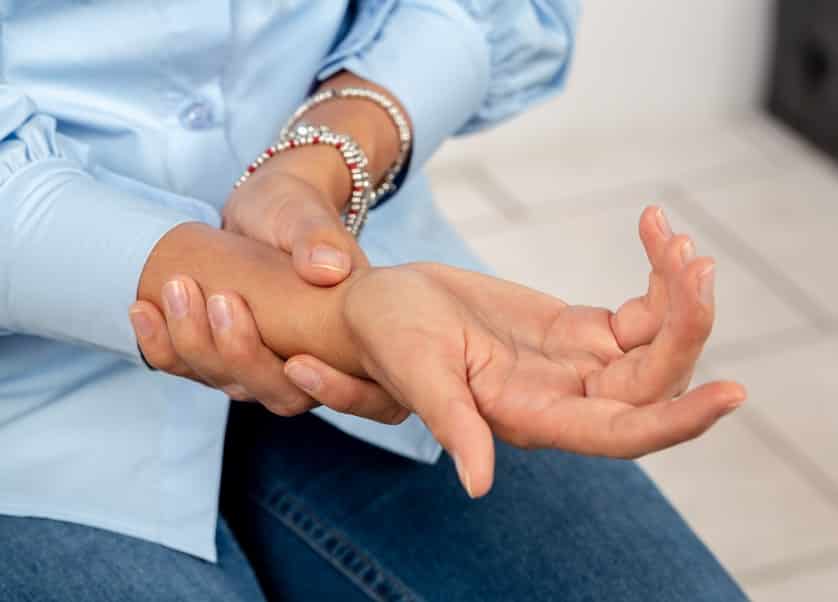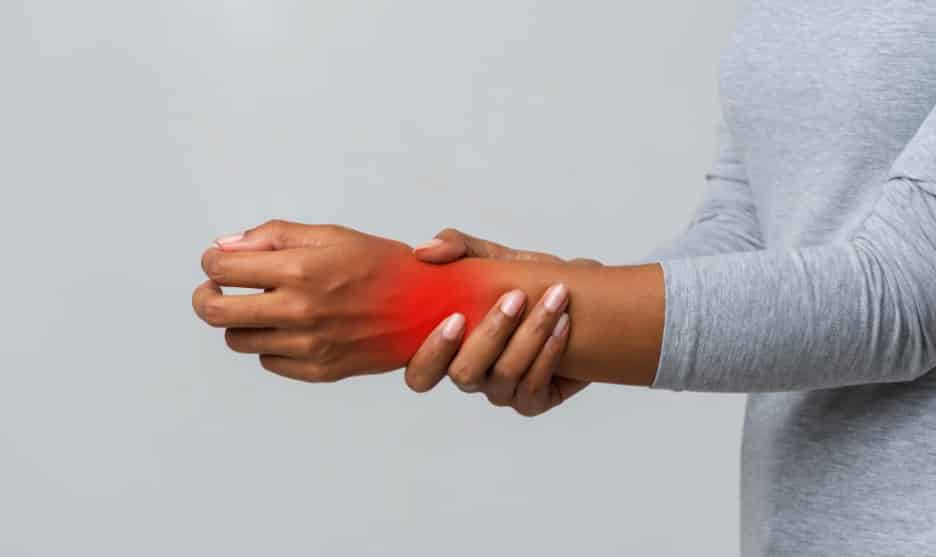Pregnancy comes with a lot of changes; to your emotions, activities, and even your body. Sometimes, these changes aren’t always friendly. A typical example of this is the occurrence of Carpal Tunnel Syndrome in pregnancy.
When it happens, carpal tunnel syndrome limits your ability to hold objects for a long period of time. Interestingly, this syndrome is common in pregnancy.

Although it occurs in only 4 percent of the population, carpal tunnel syndrome affects about 5 in every 10 pregnant women. In this article, you’d find answers to every question about carpal tunnel syndrome in pregnancy; the meaning, symptoms, causes, risk factors, diagnosis, prevention, and treatment.
Table of contents:
What is Carpal Tunnel Syndrome?
The carpal tunnel is a narrow path which links your wrist to your palm. Internally, it is surrounded by bones and ligaments. As the name implies, this is where the carpal tunnel syndrome occurs.
Carpal tunnel syndrome is the compression of the median nerve, which supplies the palm, as it crosses from the wrist into the hand. The median nerve provides sensation to your thumb, index finger, middle finger, and half of your ring finger.
Furthermore, carpal tunnel syndrome often occurs in one hand. However, it can also occur in both hands. Due to increased fluid production during pregnancy, carpal tunnel syndrome affects a large number of pregnant women.
Symptoms of Carpal Tunnel Syndrome in Pregnancy
During pregnancy, the symptoms of carpal tunnel syndrome start gradually and increase with time.
For most women, the symptoms include:
1. Numbness/Tingling Sensation In The Fingers
Remember that the median nerve supplies three and half of the fingers in your hand?
As a result of this arrangement, these are the regions affected in carpal tunnel syndrome. Most times, these fingers would feel numb or tingly. Sometimes, this sensation may even go as far up as your wrist.
In most pregnant women, this symptom is observed while driving, or holding an object like a phone or book. It may even occur as a person wakes up from sleep.
Thankfully, the little finger is not affected since it is not supplied at all by the median nerve.
2. Muscle Weakness
While suffering from carpal tunnel syndrome, your hands may feel weaker than usual. This is due to the numbness in your hand or the inability of your thumb to perform its grasping function easily.
All these symptoms result from nerve compression.
3. Swollen Fingers
In addition to the tingling sensation and numbness in the hands, pregnant women with carpal tunnel syndrome also have to deal with swollen fingers. This symptom is often linked with the increased fluid retention that comes with pregnancy. To find out more about fluid retention in pregnancy, click here.
What Are The Causes of Carpal Tunnel Syndrome?
Generally, Carpal tunnel syndrome is caused by pressure on the median nerve. This pressure may result from swelling in the carpal tunnel. In fact, whatever irritates or squeezes the median nerve in the carpal tunnel may cause carpal tunnel syndrome.

The major cause of carpal tunnel syndrome in pregnancy is fluid retention. As your body produces and retains more fluids to support your baby, the median nerve faces a higher risk of compression in the carpal tunnel.
In addition, carpal tunnel syndrome can also result from other underlying medical conditions like:
- Diabetes
- Hypertension
- Edema
- Rheumatoid Arthritis
- Wrist Fractures
What Are The Risk Factors For Carpal Tunnel Syndrome?
1. Sex
Women are more predisposed to carpal tunnel syndrome than men are. This may be because women have narrower carpal tunnel compared to men.
2. Pregnancy
As we mentioned earlier, your body retains more fluids during pregnancy. This places you at a higher risk for carpal tunnel syndrome because there is more pressure in the carpal tunnel. Thankfully, if this is the case, the excess fluid would reduce after delivery, and carpal tunnel syndrome would be a thing of the past.
3. Nerve Damaging Conditions.
Certain conditions such as diabetes increase the risk of damaging a nerve, including the median nerve.
4. Anatomic Factors
Certain anatomic features can predispose a person to carpal tunnel syndrome. A small carpal tunnel area may most likely result in carpal tunnel syndrome. A wrist fracture or dislocation can also alter the tunnel area, putting pressure on the median nerve.
5. Lifestyle Choices
Some lifestyle factors can increase a woman’s chances of having carpal tunnel syndrome while pregnant. They include excessive salt intake, sedentary lifestyle, high body mass index (BMI).
.

7. Inflammatory Conditions.
Conditions that have inflammatory components such as rheumatoid arthritis can affect the lining around the wrist tendons, resulting in pressure on the median nerve.
Diagnosis of Carpal Tunnel Syndrome
In most cases, Carpal Tunnel Syndrome is diagnosed based on your description of the symptoms to your physician. Furthermore, your doctor may choose to conduct a physical examination to confirm the diagnosis.
In addition to this, your medical history is also important.
Your doctor would also ask important questions about your medical history to confirm or eliminate the presence of any one of the underlying medical conditions mentioned earlier in this article. Finding a relationship between the past and present is really important in medical therapy.
To aid the diagnosis, your doctor may conduct a physical test to identify the extent of nerve damage. To do this, he/she would gently tap the skin above your wrist to check for any tingling sensation,
Treatment of Carpal Tunnel Syndrome
In most cases, carpal tunnel syndrome is treated by:
- Pain Medication: One of the major symptoms of carpal tunnel syndrome is pain. This pain can be treated with Corticosteroids or NSAIDs like Advil.
- Ice Therapy: You can also relieve the symptoms of carpal tunnel syndrome in pregnancy by placing an ice pack directly on your wrist. If you do this for about 10 minutes daily, it can help reduce the swelling
- Rest: As usual, rest helps. While expecting your little one, remember to rest whenever you feel pain or discomfort in your wrist.
Prevention of Carpal Tunnel Syndrome
Sadly, there’s no ultimate way of preventing carpal tunnel syndrome. However, you can reduce the stress on your wrists and hands by modifying your lifestyle choices and following these guidelines:
- Keep your fingers relaxed; As much as you can, avoid bending your fingers for long periods
- Maintain a good posture; Bad postures can affect your wrists, fingers, and hands. If this is left unchecked, nerve compression can occur.
- Take a break! Short, frequent breaks help to relax your wrists. It will be of great help in reducing pressure on your hand.
- Stay warm. Sadly, living or working in very cold environments increase the risk of carpal tunnel syndrome. Please, try to keep your hands as warm as possible. You can even try wearing a fingerless glove.
- Avoid smoking and a sedentary lifestyle.
- Treat underlying medical conditions to reduce your risk for developing carpal tunnel syndrome.
Conclusion
Carpal tunnel syndrome isn’t strange during pregnancy. If you’re experiencing any of the symptoms listed above; don’t worry, you are not alone. Thankfully, the symptoms often resolve a few months after delivery. Furthermore, early diagnosis and treatment and prevent lifelong damage to the median nerve.
Finally, if you observe any of the symptoms mentioned earlier in this article, please consult your doctor immediately.
REFERENCES
Alessia Genova, Olivia Dix, Asem Saefan, Mala Thakur, and Abbas Hassan (2020). Carpal Tunnel Syndrome: A Review of Literature. Cureus. Accessed on 26th June, 2021 from https://www.ncbi.nlm.nih.gov/pmc/articles/PMC7164699/#__ffn_sectitle
Jeremy D P Bland (2007). Carpal Tunnel Syndrome: Clinical Review. BMJ. Accessed on 26th June, 2021 from https://www.ncbi.nlm.nih.gov/pmc/articles/PMC1949464/
Park D, Kim BH, Lee SE, Kim DY, Eom YS, Cho JM, Yang JW, Kim M, Kwon HD (2021). Electrodiagnostic, Sonographic, and Clinical Features of Carpal Tunnel Syndrome with Bifid Median Nerve. Journal of Pain Research. Accessed on 26th June, 2021 from https://doi.org/10.2147/JPR.S303142

